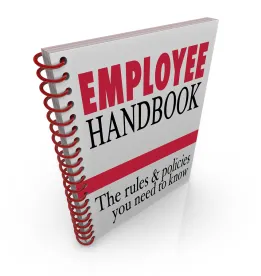Employee handbooks are an often neglected and underappreciated company document. Preparing, maintaining, and updating a handbook that reflects the policies of your company and your operations takes time and expertise. A well-written employee handbook can be an effective document to ensure compliance with applicable laws as they evolve and as new laws go into effect. An outdated handbook can be a liability.
An effective employee handbook should be drafted so that it is organized, easy to read and user-friendly. Use plain language. Disclaimers are critical and should include that the handbook is not a contract of employment and does not modify the at-will nature of employment, and that the policies within the handbook may be revised, modified, or revoked at any time, with or without notice. The handbook should set forth the expectations for employees for attendance, conduct, and discipline; however, make sure that the company retains discretion and flexibility when making decisions.
Here are some key policies that likely need updating for 2019:
Anti-Harassment Policy. This should come as no surprise, as allegations of workplace sexual harassment and the #MeToo movement have made headlines across the country. Your company’s policy can help set the tone and expectation that your company is committed to maintaining a workplace free of harassment. Typically, policies in handbooks should avoid legalese, but this is one policy where your company should explain not only what constitutes sexual harassment under the law, but also what type of conduct will violate your company’s anti-harassment policy.
Conduct that may not rise to the level of legally actionable harassment may still violate your company’s policy against harassment. A robust anti-harassment policy will have a number of channels for complaints and not just the supervisor. Oftentimes, the supervisor does not properly elevate the complaint and, of course, there needs to be another channel for bringing a complaint when the supervisor is allegedly causing the problem. Set forth a number of positions, such as the Human Resources Director or Director of Operations, and include the names, telephone numbers, and email addresses of the individuals holding those positions. It is helpful if both genders are represented. The policy should confirm that all complaints will be promptly and thoroughly investigated, confidentiality will be maintained to the extent possible, and retaliation will not be tolerated against anyone who brings a complaint in good faith.
Leave Policies. Leave policies, such as the Family and Medical Leave Act, Paid Sick Leave, and Parental Leave, may require some updating. At least nine states and multiple localities have enacted some form of Paid Sick Leave. The laws differ as to eligibility, accrual rate, covered uses, and advance notice. This is one area where you might consider a supplement specific for certain states or localities, as a one-size-fits-all approach may not be preferable given the various locations of your offices or facilities. As we previously discussed, parental leave policies should apply equally to all types of new parents. There is an important distinction between paid leave for recovering from childbirth and paid leave for bonding or other non-medical reasons. Make sure your leave policies are not inadvertently discriminatory.
Workplace Conduct and Social Media. Given recent decisions and guidance from the National Labor Relations Board, such as the “Guidance on Handbook Rules Post-Boeing”issued June 6, 2018, employers can have increased confidence that many employee handbook rules that previously were ruled invalid will not be challenged under the Board’s new legal standard. The Board recognized that many of its prior rulings, which found certain civility rules unlawful, created a conflict for employers responsible for protecting employees from harassment. The Board will now consider whether a facially neutral rule when reasonably interpreted would interfere with rights under the National Labor Relations Act. If so, the Board will strike a balance between the “nature and extent” of the “potential impact” on the right to engage in protected concerted activity and “legitimate justifications associated with the rule.” Nonetheless, this is an ever-evolving area of the law and policies still need to be carefully drafted with enough specificity to demonstrate the legitimate justification for the policy.
Employee Benefits. Your employee handbook is not the place to set forth the details of your health and welfare benefits. The handbook should provide a brief description of employee benefits subject to eligibility requirements of the employee and the individual plan. Don’t be careless with benefits eligibility based on part-time v. full-time employees. A good solution, depending on whether your company has many part-time employees, is to specify that that handbook only addresses benefits for full-time employees and then identify what part-time employees should do to understand their benefits.
Other policies that may warrant review and updating include confidentiality, reasonable accommodations, weapons, policies addressing the use of marijuana, and policies prohibiting discrimination against LGBTQ employees. Don’t let your employee handbook sit on a shelf collecting dust. It is a living document that should be regularly reviewed. When updating, obtain the assistance of human resources, technology personnel, and employment counsel and once updated, don’t forget to train your supervisors on the updated policies.



 />i
/>i

